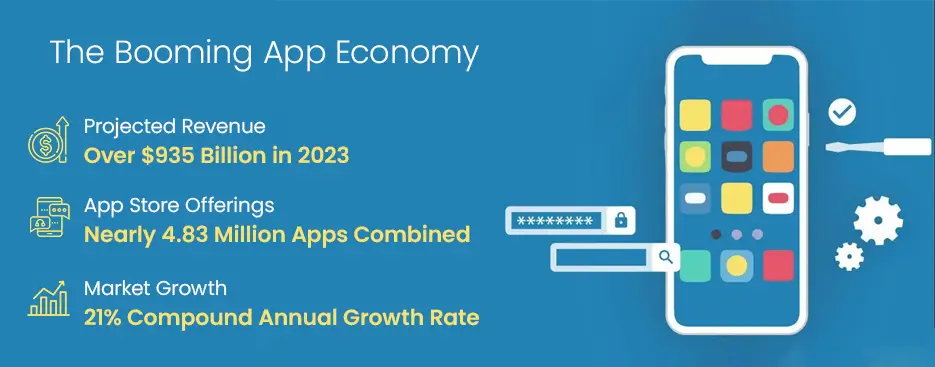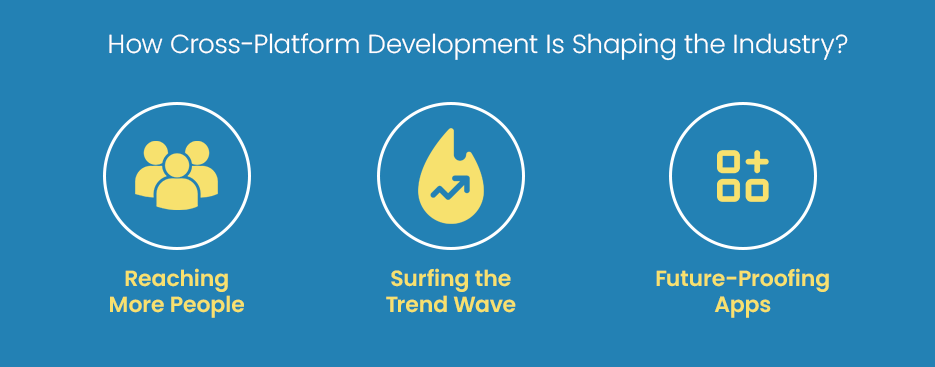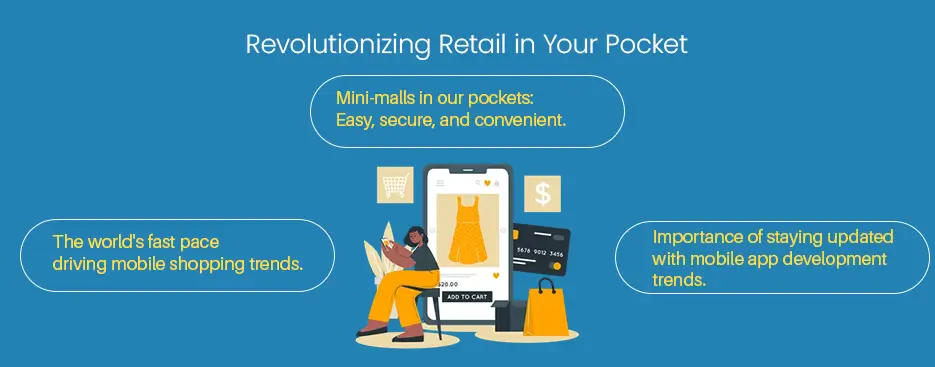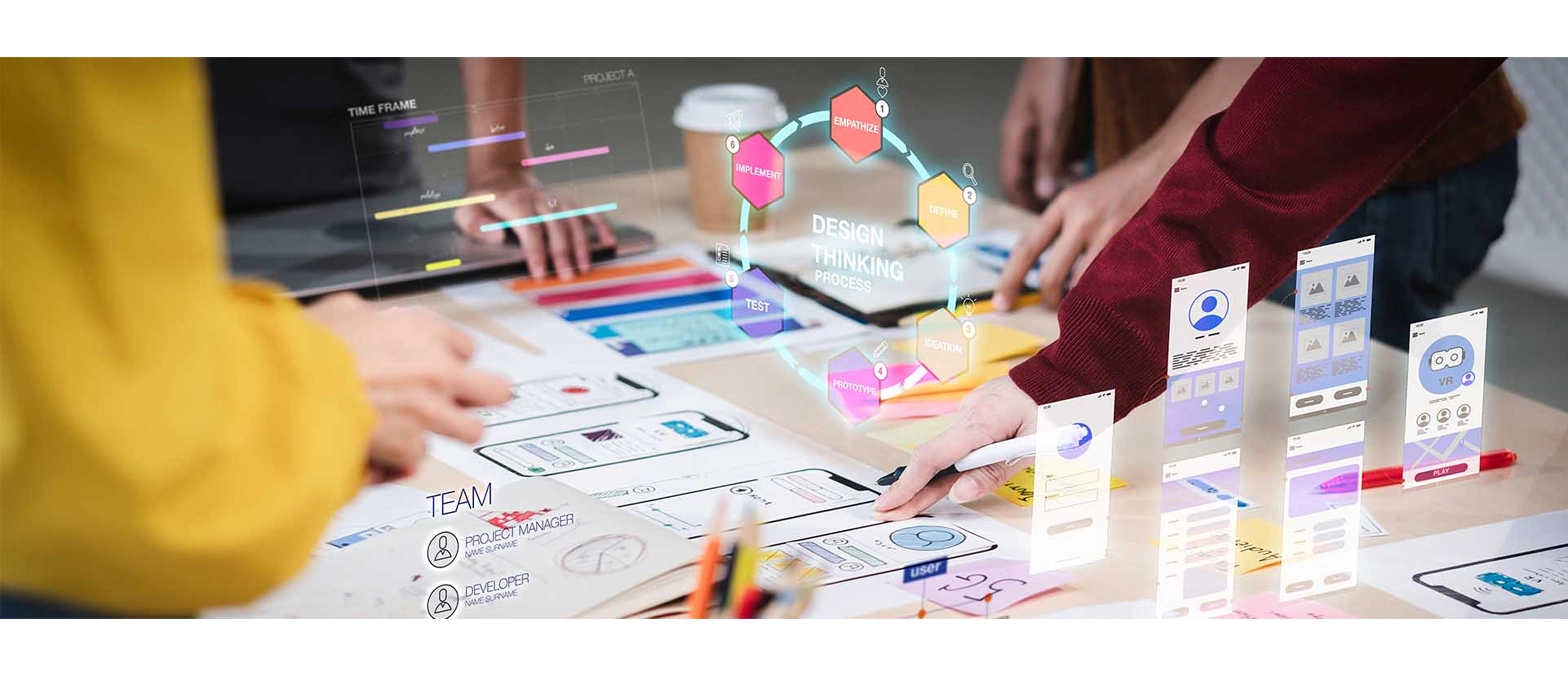Table of Contents
Mobile App development trends are a big deal for everyone in the game—whether you’re building the apps, selling them, marketing them, or using them. Knowing top mobile app development trends helps you make smart choices, like picking the best tech, designing a killer app, or developing a marketing plan that works. For instance, mobile apps are projected to generate over $935 billion in revenue in 2023, with the Apple App Store and Google Play Store offering nearly 4.83 million apps combined. This staggering number is part of a broader trend, with mobile app downloads expected to increase by 24 billion this year, marking a market growth momentum with a compound annual growth rate of close to 21%.
App makers use these insights to create stuff that we want to use. Business folks need to stay sharp and keep their apps interesting for people like us. Marketers get to plan better campaigns when they know what everyone’s into. And even for app users, understanding what’s trending helps us determine which apps are worth our time and maybe our money.
These mobile app development trends are like a sneak peek into the future of apps. These days, keeping our stuff safe in apps isn’t a nice-to-have—it’s a must. And get this: cool new tech like Augmented Reality (AR) and Artificial Intelligence (AI) is about to make apps even more amazing. If we don’t keep up with these changes, we might miss the boat as the app world speeds ahead.

Current Trends in Mobile App Development
Let’s peek at the latest waves in mobile apps this year—it’s quite the scene! The latest trends in mobile app development are all about using cutting-edge tech to make apps that are not just cool but useful for us and the folks running businesses.
1. AI and ML: Raising the Bar for App Intelligence
AI and ML are the new wizards behind the curtain, making our apps smarter than ever. They’re not just flashy extras but the heart and soul of our apps’ smarts. Take the likes of Siri or those clever keyboards that guess what you will type next. AI is about making our app chats smoother and more like talking to a real buddy.
And the genius doesn’t stop there. AI’s got a knack for picking up on the little things we like, the patterns in what we do, and it uses that to make things more our style—like suggesting a new song that gets stuck in your head or finding that perfect pair of sneakers without breaking a sweat.
As app creators prioritize intelligence, services specializing in custom app development services harness AI and ML to deliver apps that aren’t just smart—they’re mind-readers, anticipating business and user needs with finesse.
2. Increased Focus on App Security and Privacy
In a digital world with security breaches and privacy scares, app makers are buckling down on fortifying user trust through enhanced security and privacy. Users are savvy—they demand bulletproof safety for their data.
For app makers, gaining user confidence is the golden ticket. This translates to robust security measures like encryption, secure data storage, and consistent updates. And for apps juggling sensitive data, such as those in finance or healthcare, the bar is sky-high.
Privacy also means transparency about how data is handled. In response to regulations like the GDPR and CCPA, apps are upping their game, ensuring compliance not just for legalities but to win over users in a competitive marketplace.
3. 5G: The New Frontier in App Development
5G is more than a speed boost—it’s a game-changer for app capabilities. This new tech tier is paving the way for possibilities for in-app functionality.
For users, 5G means lightning-fast apps and seamless real-time interactions, especially in data-heavy apps like those for video streaming or immersive graphics.
For a custom app development agency, 5G opens up a playground of opportunities. AR and VR can now operate with virtually zero lag, and AI and ML capabilities are set to expand, making way for groundbreaking features and personalization.
As 5G rolls out, developers must gear up, optimizing apps for quicker speeds and introducing new features that previous network limitations rendered impossible.
4. User Experience
In the bustling world of mobile apps, the user experience (UX) can make or break an app’s success. With an ocean of apps, only those with a slick, intuitive UX stand out.
The mobile app development trends are clear: users crave simplicity. Cluttered menus and complicated interfaces are out; ease and clarity are in. Designing UIs that anyone can easily navigate is the prime directive for businesses looking to hire mobile app developers.
Fixing pain points like slow load times and cumbersome sign-ups is pivotal. A leading mobile app development company aims to craft a smooth experience so users stay hooked without a second thought.
Seamless User Experiences, Powerful Functionalities
Our Mobile App Development Services Have It All
Android App Development Trends
The Android app world is buzzing with fresh mobile app development trends, each shaping the horizon of what’s next. For any Android app development agency, staying ahead of the curve is crucial. Let’s zoom into what’s making waves, including embracing cutting-edge languages like Kotlin and gearing up for the fresh challenge of foldable devices.
5. Kotlin: The New Darling of Android App Development
Kotlin is revolutionizing the Android development scene. It’s got Google’s thumbs-up and has won over developers. Why? It meshes seamlessly with Java and pares down complexity, which makes it a heavyweight favorite among Android app development trends. With Kotlin, things get done quicker and smoother.
What Makes Kotlin Stand Out
- Safety: Kotlin’s thoughtful design means fewer mistakes and crashes.
- Java Compatibility: It’s a team player, slotting perfectly with Java, easing the developer’s journey.
- Efficiency: Kotlin cuts to the chase with its syntax—less fluff means quicker coding.
But Kotlin isn’t alone on the block. Other languages like Dart, powering Flutter, are on the rise, too, due to their instant visual updates and a treasure trove of ready-to-roll widgets that tick all the right boxes for devs and businesses alike.
6. The New Playgrounds for Android: Foldable Devices
Foldable screens are the new frontier for Android, bringing both head-scratchers and opportunities. App creators rethink how apps look and feel as screens bend and flex.
Foldable Challenges
- Seamless Screen Transition: Apps must keep cool as devices flip and flop between forms.
- Doing More at Once: Foldables’ knack for multi-tasking means apps must juggle multiple tasks and screen shapes with finesse.
- Adaptable Designs: Apps must be chameleons, shifting shape while maintaining functionality and style.
Foldable Opportunities
- A Richer Experience: With more screen real estate, foldable elevates everything from gaming to productivity.
- Innovation in Features: The quirky foldable build lets developers play with novel app features that, before, just couldn’t take wing.
Keeping up with these mobile app development trends isn’t just smart—it’s essential for anyone in the Android app space who wants to make an impact.
iOS App Development Trends
In the dynamic realm of technology, iOS app development companies are in constant flux, continuously aligning themselves with the latest offerings from Apple. For any iOS development agency for Apple’s ecosystem, it’s critical to stay abreast of these evolving tides. Let’s explore the ripples caused by iOS updates in the mobile app development trends and uncover why Swift is the go-to language for crafting sleek, efficient iOS applications.
7. Adapting to iOS’s Evolution
Apple’s regular rollouts of iOS updates serve a dual purpose: they introduce cutting-edge features and enhancements while simultaneously setting new benchmarks for app developers. These updates are not just about added gloss—they demand that developers stay nimble, ready to navigate shifts in design directives, fortified security protocols, and an array of fresh functionalities.
Three Ways iOS Updates Make Waves
- Design Overhaul: New updates may bring about a fresh set of design guidelines, compelling apps to undergo aesthetic or functional redesigns to remain in vogue.
- Bolstering Security: As Apple beefs up its security frameworks, developers ensure their apps are impregnable, adhering to the latest safety criteria.
- Feature-Rich Enhancements: With each update, there’s a playground of new capabilities that developers can harness to elevate the user experience of their apps.
For iOS app development agencies, staying one step ahead is not just beneficial—it’s essential. They’re expected to deliver modern solutions that resonate with users and align seamlessly with Apple’s stringent standards.
8. Swift: The Vanguard of iOS Efficiency
Swift has swiftly redefined the game since its inception, becoming a cornerstone in the toolkit of iOS developers. This potent programming language is renowned for its simplicity and efficacy, which is why the iOS app development services have wholeheartedly embraced it.
Here’s Why Everyone’s Loving Swift
- Speedy Development: Swift’s got this easy-to-get language that lets developers whip up apps fast, cutting down the hours of typing code.
- Snappy Apps: It’s quick to write; it makes apps run like the wind. We’re talking about buttery-smooth swipes and taps for everyone using them.
- No More Memory Mess: Swift’s smart with memory, making apps more like nimble athletes than memory hogs that slow down your phone.
Apple’s betting big on Swift, and it’s here to stay at the top of the iOS app-making toolbox. For the tech wizards building our apps, getting good at Swift is like grabbing a ticket to the future—it’s their secret sauce for making sure the apps we love today are ready for tomorrow.
In a nutshell, for the folks bringing apps to life on iOS, these mobile app development trends are more than just the month’s flavor—they’re their chance to shine and stay ahead of the game. Keeping up with the latest from iOS and mastering Swift means their apps will keep up with the times and set the pace for what’s to come.
The Rising Tide of Cross-Platform App Creation
In the fast-paced app universe, there’s a big shift going on—mobile app development services are getting into making apps that feel at home on any device, whether it’s your iPhone or Android. It’s all happening in the US, which is the cool kid on the block regarding tech innovation.
9. Making App Magic with Flutter & React Native
So, these tools called Flutter and React Native are shaking things up. Imagine writing your app’s story just once, and it fits perfectly on both Apple and Android devices—that’s what these frameworks do. It’s like having a universal key that unlocks all doors, making the app-building process smoother and faster.
Saving Money
For any mobile app development company in United States and elsewhere, your wallet is gonna feel heavier. Why? Because making one app that stretches across all platforms is way cheaper than crafting separate ones for each system. It’s smart money, plain and simple.
Uniform on All Devices
Whether swiping on your phone or tapping on your tablet, React Native and flutter app development services ensure the app looks and feels the same. This way, the vibe of the app—its style and the journey you take in it—doesn’t get lost in translation.
Speedy Delivery to App Stores
These frameworks are like express lanes, getting apps into people’s hands quicker. This means launching the app fast and zipping out updates and new stuff to keep users hooked.
How Cross-Platform Development Is Shaping the Industry?

- Reaching More People: By playing nice with iOS and Android, apps cast a wider net—catching more people’s eyes, no matter what gadget they’re glued to.
- Surfing the Trend Wave: Jumping on the cross-platform train is hot in app development. In a sea of apps, all jostling for attention, using these tools is like having a secret weapon for building apps that stand out and can bend with the times.
- Future-Proofing Apps: Tech is always on the move, but apps built with cross-platform in mind are ready to roll with the punches, keeping up with new mobile app development trends as they pop up.
Trending Mobile App Development Technologies
The app development domain is in a perpetual evolution, with new technologies continually entering the scene. For businesses and specialized app developers, staying attuned to these advancements isn’t just beneficial—keeping them at the forefront of the digital race is imperative.
Some key technologies include
- Augmented Reality (AR)
- Virtual Reality (VR)
- Internet of Things (IoT)
AR VR Solutions are changing gaming and shopping with new experiences. IoT is making things more connected by linking different devices and apps.
These aren’t just fancy words; they’re shaping mobile app development trends. They push developers and best app development agencies to be creative and keep innovating. This leads to more intuitive, interactive, and secure apps that meet various needs and likes.
10. AR, VR, and IoT in Mobile Apps
AR in mobile apps brings us to a world where digital info mixes with reality. This tech is now on smartphones, giving users an immersive experience. For example, retail apps use AR to let people see products in their homes before buying. Education apps use AR for interactive learning. It’s a growing trend in mobile app development.
VR goes further in immersion. It creates a fully digital world, cutting off the real world. Mobile apps use VR in games, education, and training, offering a deep and realistic experience. VR’s use in therapy shows its big potential beyond just fun.
IoT application development is about connecting everything. Imagine controlling home appliances or cars from an app. IoT is making this real. It brings convenience, better safety, and energy savings to apps, marking it a key among mobile app development trends.
Future of These Technologies in Apps
While AR and VR are big in games now, they have a larger future. They will soon be key in healthcare, education, real estate, and tourism. Picture an app for virtual tours of historical places with AR or VR in medical training. These ideas are quickly becoming real.
IoT’s future in apps looks bright, aiming for smarter, more efficient living. Expect advancements in home automation, health monitoring, and smart cities. AI combined with IoT will make apps more personal and predictive.
As these technologies advance, their use in apps will blend more smoothly into our lives. AR and VR will fit better in our daily activities, and IoT will make using devices smarter and more natural.
There’s a wave of opportunity for businesses, large and small, courtesy of the latest technological advancements. A top mobile app development company in US and globally is harnessing these mobile app development trends to craft cutting-edge solutions. Those specializing in iOS app creation are keenly exploring these technologies to amplify the performance of applications on Apple gadgets.
11. Mobile Shopping: The New Normal
Let’s face it: our world’s always on fast-forward, and buying stuff with our phones is changing the game. It’s like we’ve all got mini-malls in our pockets now—just a few taps, and voilà, that new book or pair of shoes is coming. So, It’s not just about snagging stuff easily. It’s also about keeping your card details safe with top-notch payment tech. For any shop, staying sharp with the mobile app development trends is key to keeping in the race.

Why We’re All About Shopping Apps
Convenience is King
Shopping apps are like having your favorite stores at your fingertips—browse, pick, and check out while chilling at home or on your bus ride to work. They’re smart, too, figuring out what you’re into and suggesting stuff you might like. For stores, this is a game-changer for connecting with us shoppers on a whole new level.
Mobile-First: The New Normal
In today’s e-commerce scene, you’re behind the curve if you’re not prioritizing mobile users. People aren’t just shopping on their phones—they expect it to be a breeze. That’s where mobile application development consulting services step in, guiding businesses to thrive in the crowded digital bazaar with user-friendly, swift, and dependable apps.
Stepping Up Security and Payments on Shopping Apps
Fort Knox-level Security
With a boom in-app purchases, iron-clad security isn’t optional—it’s a necessity. Think military-grade encryption and biometric security. These features give shoppers the peace of mind to freely tap, shop, and purchase without fretting over their data.
The Evolution of Payments
M-commerce apps are broadening the horizon for payment options. From credit cards to digital wallets, they’re not just diverse; they’re also becoming more intelligent. Each tap-to-pay is designed to be as smooth as a seamless checkout experience should be.
12. Going Green with Apps
These days, apps are doing more than just making life convenient—they’re going green. This isn’t only about apps related to the environment and how they’re made. Writing code that’s kinder to the planet, known as ‘green coding,’ is catching on. It’s a sign of shifting towards technology conscious of its ecological footprint. For enterprise mobile app development, tuning into these mobile app development trends is key to staying in touch with both the planet and the times.
How Apps Are Making a Difference for the Environment
Our phones can be more than gadgets; they can be teachers. Apps that show us how to live sustainably, reduce our carbon footprint, or recycle more effectively turn learning into a fun, interactive experience. They make it simple for us to take better care of our planet with every tap and swipe.
Learning about being eco-friendly is one thing, but some apps prompt us to do it. They might offer rewards for eco-friendly shopping or for saving energy at home. These apps aren’t just talk—they actively nudge us towards making daily greener choices.
Green Coding and Its Impact on App Development
Green coding makes apps that don’t ask much about our planet. It’s about efficient code that doesn’t need as much power, which means devices can run cooler and data centers can take a breather. It’s like a high-five to the environment from the tech community.
Apps don’t hog space on our phones or the cloud when coded as lean and mean. This makes our apps run smoother and eases up on the internet’s backbone, keeping everything running like a well-oiled machine. Plus, cutting down on digital excess gives the planet a big thumbs up.
13. Chatbots: The New Talk of the Town in Apps
Now, let’s discuss how apps are becoming our new talkative pals. Chatbots are all the rage and turning up everywhere in the app world.
Forget about those old bots that could only cough up canned responses. Modern chatbots are ready to gab and can keep up with a conversation like a real person. They get what you’re saying and fire back with helpful answers without skipping a beat.
Here’s why chatbots in apps are a big win
- They’re like a 24/7 help desk. Got a question at 3 a.m.? No problem. Chatbots don’t sleep, so they’re always there to help, which is perfect for businesses with customers in different time zones.
- They’re multitasking wizards. While humans can only do so much at once, chatbots can handle many questions simultaneously—like a super-efficient helper that never needs a break.
- They get to know you. The more you chat, the more they learn. Before you know it, they’re offering recommendations and remembering your last conversation. This personal touch can turn a plain app into your new favorite.
But it’s not just about slapping a chatbot into an app. It has to make sense. For shopping apps, a chatbot can be like your personal shopper, helping you find what you need or giving you the scoop on the latest deal.
Book 30 Minutes Free Consultations with A3logics Experts to Start Your App Journey Today!
Wrapping It Up
Creating apps is like racing to be first—it’s all about whipping up something super easy for everyone to use, secure, and jam-packed with cool, new features. We’re riding a huge wave of change in mobile app development trends, from using your favorite apps on any device to effortless online shopping, not to mention eco-friendly tech that’s better for the earth. And hey, a little wisdom from expert app consultants can make a massive difference.
What’s On the Horizon?
- Your Home in Your Hand: Picture this—you’re at work but can flick off your living room lights with a tap on your phone. That’s the future we’re cruising toward, with apps that play nice with all the gadgets in your life.
- Speedy Apps with 5G: Brace yourself for apps that zip and zoom like never before, thanks to 5G. Imagine apps that load in a blink and feel like they’re one step ahead of you, making augmented reality and live streams unbelievably smooth.
- Chit-Chat with Your Apps: Wouldn’t it be cool to chat with them and have them do what you say? Voice commands are turning that cool idea into reality, making technology something you can use without even lifting a finger—perfect when you’re out and about or your hands are tied up.
Have an amazing app concept? Don’t sit on it—connect with the top app developers through A3Logics in the industry and kickstart your journey to build something truly remarkable.
FAQs
What’s Everyone Buzzing About in App Development These Days?
It’s all about how AI (Artificial Intelligence) and ML (Machine Learning) are shaking things up. Imagine your apps getting to know you – your likes, your routines – and then tailoring themselves to fit your life just right, like that favorite pair of jeans that gets better with time. It’s about apps that don’t just sit there on your phone but adapt to you.
How’s AI Making Waves in App Development?
AI is rewriting the rules in the world of app creation. It’s all about making our interactions with apps feel more like a chat with a friend – easy, natural, and intuitive. Thanks to AI, apps are getting faster, smoother, and smarter at understanding what we need, sometimes even before we do. For the folks building these apps, AI is like having a secret insight into what users want, helping them fine-tune everything to give us exactly that.
Why is there a push to develop apps compatible with both iOS and Android?
Developing apps that function seamlessly on iOS and Android devices is highly sought because it maximizes efficiency and cost-effectiveness. With advanced frameworks like Flutter and React Native, these cross-platform apps deliver consistent and smooth performance across different devices. This approach is economically advantageous for developers and provides a unified user experience, benefiting consumers using various smartphone types.
Are AR and VR turning the app world on its head?
Totally! AR (Augmented Reality) and VR (Virtual Reality) are busting out of the gaming zone and into places like shops, classrooms, and even doctor’s offices, making the way we use apps more fun and hands-on. They’re giving us a ticket to explore digital worlds in crazy cool new ways that used to be the stuff of sci-fi.
What’s the deal with being green in app development?
Green is the new black in the app world. Devs are getting serious about coding in nicer ways to Mother Nature and building apps that nudge us toward living greener lives, too. It’s a sign that the tech folks are stepping up to take better care of the planet, and that’s a big deal.






